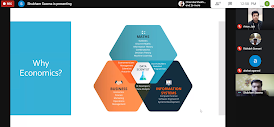Nudge thinking is the use of
elective architecture and other techniques in behavioural science to influence
the decisions people make. Nudge theory was formulated in 2008 by Thaler and
Sunstein in their book Nudge: Improving Decisions about Health, Wealth, and
Happiness. It is an approach to understand the changing people's behaviour by
analysing and improving designs that propose people free choices to generate
more beneficial results for themselves and society than outcomes from
traditional forced direct changes and compared to designs with indirect
influence.
Behavioural economics examines how people make decisions in the real world, and how irrational biases are applied in public policy. Many governments have implemented well-informed policies that focus on nudge interventions to preserve freedom of choice by steering people in certain directions.
Nudge testing, conducted by
government agencies in the United Kingdom, Australia, Germany, the Netherlands,
Singapore, and the United States, deviates from traditional policy instruments
which encourage certain behaviours without restricting individual options or
imposing financial penalties. Nudges, however, are no substitute for
traditional economic policy instruments.
As behavioural change requires a
combination of interventions and nudges often rely as much on important
information provision and selection issues as on a range of government
resources. Moreover, there is a tendency to underestimate the cost of nudges
because they are easy to understand for policymakers rather than engaging in
sophisticated and long research-based policy, nudges make them attractive in
a low-capacity environment. Moreover, implementing nudges can serve as a
signal to politicians, voters, and governments that rely on behavioural science
can improve policy.
The attractiveness of nudging is partly due to the relatively low cost of behavioural interventions, which seem particularly applicable in the age of austerity, and because they complement conventional policy tools such as legislation and regulation. Since the launch of the Behavioural Insights Team during David Cameron's premiership is 2010, the UK has hosted the concept of a nudging unit, and concepts of nudge-related programs have begun to populate the political repertoire of the public administration, migrating from the remote realm of corporate governance and international governance. More than a dozen countries have established offices known as "nudge units" that conduct experiments with behavioural science methods.
As prime minister of Britain, David Cameron formed the Behavioural insights Team that pursued a NUDGE strategy for organ donation at driver’s license centres and found that it led to 100,000 new volunteers in a single year. President Barack Obama had his agencies investigate in 2015, implemented a behavioural science insights policy across the federal government by executive order.
In India, NITI Aayog, the government’s think
tank, is looking to hire behavioural economists for its ‘nudge unit’ to
understand behavioural changes to make more effective policies and programmes,
especially in the health and education sectors. This year’s Economic Survey
authored by Chief Economic Advisor K.V. Subramanian devoted a whole chapter to
behavioural economics and sought the fixing of the ‘nudge unit’ in NITI Aayog.
The survey had talked about how behavioural
economics had been one among the explanations behind the success of a number of
the Narendra Modi government’s flagship schemes like Swachh Bharat and Beti
Bachao Beti Padhao(BBBP). It had even set a more ambitious agenda to cause
social change, including moving from BBBP to ‘BADLAV’ (Beti Aapki Dhan Lakshmi
Aur Vijay Lakshmi) and from Swachh Bharat to ‘Sundar Bharat’. Against this
background, the research team, which includes academics, practitioners, and
governments examined existing studies to assess the relative cost-effectiveness
of nudges and other policy interventions. Nudging is influenced by a growing
body of research in the field of behavioural economics.
By Sheldon Patrick Joseph


















